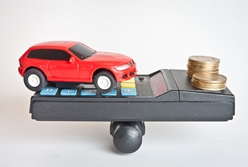 Given the high cost of automobiles, most people must finance the purchase of one. If they do not put down a large down payment, the vehicle can quickly become worth less than what they owe because vehicles depreciate—or lose value—as soon as they are driven off the dealership lot. This can be a huge problem if you are the victim of an auto accident and your vehicle is totaled by the insurance company. You may be shocked to discover that the insurance company is offering less in settlement for your vehicle than what you owe on the vehicle’s loan. Are they allowed to do this?
Given the high cost of automobiles, most people must finance the purchase of one. If they do not put down a large down payment, the vehicle can quickly become worth less than what they owe because vehicles depreciate—or lose value—as soon as they are driven off the dealership lot. This can be a huge problem if you are the victim of an auto accident and your vehicle is totaled by the insurance company. You may be shocked to discover that the insurance company is offering less in settlement for your vehicle than what you owe on the vehicle’s loan. Are they allowed to do this?
Does an Insurance Company Have to Pay the Balance Owed on a Car Loan When a Vehicle Is Totaled?
An insurance company will total a vehicle if the cost to repair it is more than what it is worth or if it will remain unsafe even after it is repaired. Unfortunately, an insurance company totaling a vehicle is not required to pay the car loan balance in a settlement. The insurance company is only obligated to pay the Actual Cash Value (ACV) of the vehicle—the amount you will need to purchase a comparable used vehicle. The insurance company may use a software program to calculate your vehicle’s ACV or Internet sites, such as Kelly Blue Book and National Automobile Dealers Association Used Car Guide (NADA). This amount can be far less than what you owe on your vehicle loan.
What Should You Do If You Still Owe on Your Car Loan After Your Car Is Totaled?
If you owe more than your vehicle is worth, you should take certain steps to protect yourself. These steps include the following:
- Be certain the ACV is correct. It is even more crucial that you receive the true ACV when you will still owe a loan on your vehicle, so you need to check the insurance company’s valuation. In many cases, the insurance adjuster may be offering less than what you are owed. You can get an estimate of the ACV by going to Internet sites such as Kelly Blue Book and finding out the retail price—the amount you would receive in a private sale—and the dealer trade-in amount. Be certain you have your vehicle’s make, model, trim, mileage, and any optional features so that you obtain an accurate figure. You will add the retail and trade-in amounts and divide the total by two to determine the ACV. It is a good idea to repeat this process on more than one website. Doing this could increase your settlement by thousands of dollars—which would be used to reduce the loan balance you owe.
- File a gap insurance claim. If you purchased gap insurance when you obtained your car loan, you can contact the insurance company directly or have your lender to make a claim. Gap insurance may pay the difference between the ACV and what is owed on your auto loan so that you do not owe a balance.
- Pay your car loan payments. Until your insurance claim is settled, you should continue making your automobile loan payments on a timely basis to not default on your loan. If you did not purchase gap insurance and your vehicle is totaled, you will owe any balance of your car loan above the ACV payment. You are legally responsible for paying the full balance owed to the lender—even though you no longer have your car and may need to finance the purchase of a new one. You will need to contact the lender to make payment arrangements.
If you will not have a large down payment to pay on the vehicle you purchase to replace your totaled one, you may want to consider purchasing gap insurance to protect yourself in case this new vehicle is totaled in the future.
Do you have questions regarding your property damage claim after an auto accident? Did you or a family member suffer injuries? Start an online chat today to schedule a free, no-obligation consultation to find out about your legal rights and options.
Related Links:














